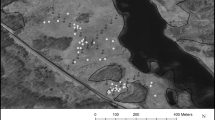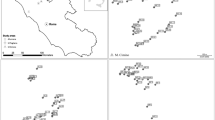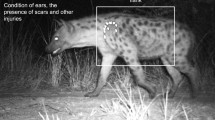Abstract
The critically endangered weevil, Hadramphus tuberculatus (Pascoe 1877), was considered extinct until its rediscovery in 2004. Once widespread throughout the Canterbury Plains, currently the only known population is at Burkes Pass Scenic Reserve, Canterbury, New Zealand. Little information regarding the ecology and behaviour of this species has been recorded. A mark-recapture study was conducted over 3 years (2009–2011) to obtain more information on the population size, sex-ratio, and weevil movement within the reserve. Non-lethal pitfall traps were used for live capture of H. tuberculatus; weevils were measured, sexed, photographed, and given a unique ID on the elytra. Analysis of the mark-recapture data indicated a decrease in population size over the 3 years with estimated population sizes of 138 in 2009, 90 in 2010 and 76 in 2011. The sex-ratio of the population was even. In addition to mark-recapture, methods of captive rearing were explored. The results from this study will be used to assist conservation of H. tuberculatus and provide valuable information for developing an ex situ breeding program. We suggest that the population is vulnerable and must be carefully managed if extinction is to be avoided.






Similar content being viewed by others
References
Allan HH (1961) Flora of New Zealand, vol 1. R. E. Owen, Government Printer, Wellington
Barratt BIP, Ferguson CM, Logan RAS, Barton D, Bell NL, Sarathchandra SU, Townsend RJ (2005) Biodiversity of indigenous tussock grassland sites in Otago, Canterbury and the central North Island of New Zealand I. The macro-invertebrate fauna. J R Soc N Z 35:287–301. doi:10.1080/03014223.2005.9517785
Barratt BIP, Ferguson CM, Barton D, Johnstone PD (2009) Impact of fire on tussock grassland invertebrate populations. Sci Conserv 291:75
Bauerfeind S, Theisen A, Fischer K (2009) Patch occupancy in the endangered butterfly Lycaena helle in a fragmented landscape: effects of habitat quality, patch size and isolation. J Insect Conserv 13:271–277. doi:10.1007/s10841-008-9166-1
Bennett BG (1987) Observations on rearing Karocolens pittospori (Coleoptera: Curculionidae: Molytinae). N Z Entomol 9:34–37
Brockerhoff EG, Shaw WB, Hock B, Kimberley M, Paul T, Quinn J, Pawson SM (2008) Re-examination of recent indigenous cover in New Zealand and the relative contributions of different land uses. N Z J Ecol 32:115–126
Brouwers N, Newton A (2009) Habitat requirements for the conservation of wood cricket Nemobius sylvestris (Orthoptera: Gryllidae) on the Isle of Wight, UK. J Insect Conserv 13:529–541. doi:10.1007/s10841-008-9199-5
Buhl PN, Sarfati MS, Brockerhoff EG, Kelly D (2008) Description, phenology and biology of Zelostemma chionochloae Buhl sp. nov., a platygastrid parasitoid of Eucalyptodiplosis chionochloae (Diptera: Cecidomyiidae) in New Zealand. N Z J Zool 35:255–264. doi:10.1080/03014220809510122
Bull RM (1967) A study of the large New Zealand weevil, Lyperobius huttoni Pascoe 1876 (Coleoptera: Curculionidae, Molytinae). Victoria University of Wellington, Wellington
Campbell AD (1981) Flowering records for Chionochloa, Aciphylla, and Celmisia species in the Craigieburn Range, South Island, New Zealand. N Z J Bot 19:97–103
Connor HE (1965) Tussock grasslands in the middle Rakaia Valley, Canterbury, New Zealand. N Z J Bot 3:261–276. doi:10.1080/0028825x.1965.10429020
Craw RC (1999) Fauna of New Zealand: Molytini number 39. Manaaki Whenua Press, Lincoln
Department of conservation (2000) policies and plans: Land Unit: I38011, Burkes Pass Scenic Reserve. In: Canterbury conservation management strategy, vol 2
Fountain ED (2008) The search for Hadramphus tuberculatus and the future of this nationally endangered weevil. Unpublished report for Lincoln University
Hay J, Kelly D, Holdaway RJ (2008) Causes and consequences of frequent flowering on edges in the mast-seeding genus Chionchloa (Poaceae). N Z J Ecol 32:80–91
Heisswolf A, Reichmann S, Poethke H, Schröder B, Obermaier E (2009) Habitat quality matters for the distribution of an endangered leaf beetle and its egg parasitoid in a fragmented landscape. J Insect Conserv 13:165–175. doi:10.1007/s10841-008-9139-4
Hodgson JA, Moilanen A, Wintle BA, Thomas CD (2011) Habitat area, quality and connectivity: striking the balance for efficient conservation. J Appl Ecol 48:148–152. doi:10.1111/j.1365-2664.2010.01919.x
Huggins RM (1989) On the statistical analysis of capture experiments. Biometrika 76:133–140. doi:10.1093/biomet/76.1.133
Hunt MR (1996) The distribution and habitat requirements of the large speargrass weevil (Lyperobius huttoni) and characteristics of host speargrass plants (Aciphylla squarrosa) and their vegetation associations. Victoria University Wellington, Wellington
Iles J (2007) Conservation and biology of the rediscovered nationally endangered Canterbury knobbled weevil Hadramphus tuberculatus. Unpublished report for Lincoln University, Lincoln
Johns PM (2006) Burkes Pass Scenic Reserve: Report on the endangered weevil Hadramphus tuberculatus. Unpublished report for Department of Conservation, Christchurch
Kelly D, Turnbull M, Pharis R, Sarfati M (2008) Mast seeding, predator satiation, and temperature cues in Chionochloa (Poaceae). Popul Ecol 50:343–355. doi:10.1007/s10144-008-0109-1
Kuschel G (1971) Entomology of the Aucklands and other islands south of New Zealand. Pac Insects Monogr 27:225–259
Kuschel G, Worthy TH (1996) Past distribution of large weevils (Coleoptera: Curculionidae) in the South Island, New Zealand, based on Holocene fossil remains. N Z Entomol 19:15–22
Launer AE, Murphy DD (1994) Umbrella species and the conservation of habitat fragments: a case of a threatened butterfly and a vanishing grassland ecosystem. Biol Conserv 69:145–153. doi:10.1016/0006-3207(94)90054-x
Leschen RAB, Marris JWM, Emberson RM, Nunn J, Hitchmough RA, Stringer IAN (2012) The conservation status of New Zealand Coleoptera. N Z Entomol 35:91–98. doi:10.1080/00779962.2012.686311
Lloyd DG, Webb CJ, Primack RB (1980) Sexual strategies in plants. II. Data on the temporal regulation of maternal investment. New Phytol 86:81–92
Malumbres-Olarte J, Vink CJ, Ross JG, Cruickshank RH, Paterson AM (2012) The role of habitat complexity on spider communities in native alpine grasslands of New Zealand. Insect Conserv Divers. doi:10.1111/j.1752-4598.2012.00195.x.10.1111/j.1752-4598.2012.00195.x
Mark AF (1969) Ecology of snow tussocks in the mountain grasslands of New Zealand. Plant Ecol 18:289–306. doi:10.1007/bf00332843
Mark AF, Adams NM (1995) New Zealand alpine plants. Godwit Publishing, Auckland
Mark AF, Pascale M, Dickinson KJM, McLennan B (2009) The conservation (protected area) status of New Zealand’s indigenous grasslands: an update. N Z J Bot 47:53–60
McEwen WM (1987) Ecological regions and districts of New Zealand. Number 4. Department of conservation, biological resource centre, Wellington
Meurk CD, Walker S, Gibson RS, Espie P (2002) Changes in vegetation states in grazed and ungrazed Mackenzie Basin grasslands, New Zealand, 1990–2000. N Z J Ecol 26:95–106
Moller H, MacLeod CJ, Haggerty J, Rosin C, Blackwell G, Perley C, Meadows S, Weller F, Gradwohl M (2008) Intensification of New Zealand agriculture: implications for biodiversity. N Z J Agric Res 51:253–263. doi:10.1080/00288230809510453
Molloy BPJ, Burrows CJ, Cox JE, Johnston JA, Wardle P (1963) Distribution of subfossil forest remains, eastern South Island, New Zealand. N Z J Bot 1:68–77. doi:10.1080/0028825x.1963.10429322
Murphy DD, Freas KE, Weiss SB (1990) An Environment-metapopulation approach to population viability analysis for a threatened invertebrate. Conserv Biol 4:41–51. doi:10.1111/j.1523-1739.1990.tb00266.x
Murray T, Dickinson K, Barratt B (2006) Associations between weevils (Coleoptera: Curculionidea) and plants, and conservation values in two tussock grasslands, Otago, New Zealand. Biodivers Conserv 15:123–137
O’Connor KF (1986) The implications of past exploitation and current developments to the conservation of south island tussock grasslands. N Z J Ecol 5:97–107
Otis DL, Burnham KP, White GC, Anderson DR (1978) Statistical inference from capture data on closed animal populations. Wildlife Monographs: 3–135
Rose AB, Platt KH, Frampton CM (1995) Vegetation change over 25 years in a New Zealand short-tussock grassland: effects of sheep grazing and exotic invasions. N Z J Ecol 19:163–174
Schöps K (2000) Metapopulation dynamics of the coxella weevil. Sci Conserv 134:1–37
Schöps K (2002) Local and regional dynamics of a specialist herbivore: overexploitation of a patchily distributed host plant. Oecologia 132:256–263
Schöps K, Wratten SD, Emberson RM (1999) Life cycle, behaviour and conservation of the large endemic weevil, Hadramphus spinipennis on the Chatham Islands, New Zealand. N Z J Zool 26:55–66
Strauss B, Biedermann R (2005) The use of habitat models in conservation of rare and endangered leafhopper species (Hemiptera, Auchenorrhyncha). J Insect Conserv 9:245–259. doi:10.1007/s10841-005-8818-7
Wedekind C (2002) Manipulating sex ratios for conservation: short-term risks and long-term benefits. Anim Conserv 5:13–20. doi:10.1017/s1367943002001026
Wettstein W, Schmid B (1999) Conservation of arthropod diversity in montane wetlands: effect of altitude, habitat quality and habitat fragmentation on butterflies and grasshoppers. J Appl Ecol 36:363–373. doi:10.1046/j.1365-2664.1999.00404.x
White GC, Burnham KP (1999) Program MARK: survival estimation from populations of marked animals. Bird study 46(Supplement):120–138
White EG, Sedcole JR (1993) A study of the abundance and patchiness of cicada nymphs (Homoptera: Tibicinidae) in a New Zealand subalpine shrub-grassland. N Z J Zool 20:38–51. doi:10.1080/03014223.1993.10423242
Wilson K-J (2004) Flight of the Huia: ecology and conservation of New Zealand’s frogs, reptiles, birds and mammals. Canterbury University Press, Christchurch
Young LM (2006) Masting and insect pollination of the dioecious alpine herb Aciphylla. Lincoln University, Canterbury
Young LM, Marris JWM, Pawson S (2008) Back from extinction: rediscovery of the Canterbury knobbled weevil Hadramphus tuberculatus (Pascoe 1877) (Coleoptera: Curculionidae), with a review of its historical distribution. N Z J Zool 35:323–330
Acknowledgments
We like to thank the Miss E L Hellaby Indigenous Grasslands Research Trust for providing funding for this research. Also, we like to thank After Environment Canterbury, Mohamed bin Zayed Species Conservation Fund and the Department of Conservation for providing financial assistance for the 2011 field season. Thank you to Mike Bowie for help with the weevil. Furthermore, we want to acknowledge Victoria Smith for assistance with editing and formatting.
Author information
Authors and Affiliations
Corresponding author
Rights and permissions
About this article
Cite this article
Fountain, E.D., Wiseman, B.H., Cruickshank, R.H. et al. The ecology and conservation of Hadramphus tuberculatus (Pascoe 1877) (Coleoptera: Curculionidae: Molytinae). J Insect Conserv 17, 737–745 (2013). https://doi.org/10.1007/s10841-013-9557-9
Received:
Accepted:
Published:
Issue Date:
DOI: https://doi.org/10.1007/s10841-013-9557-9




